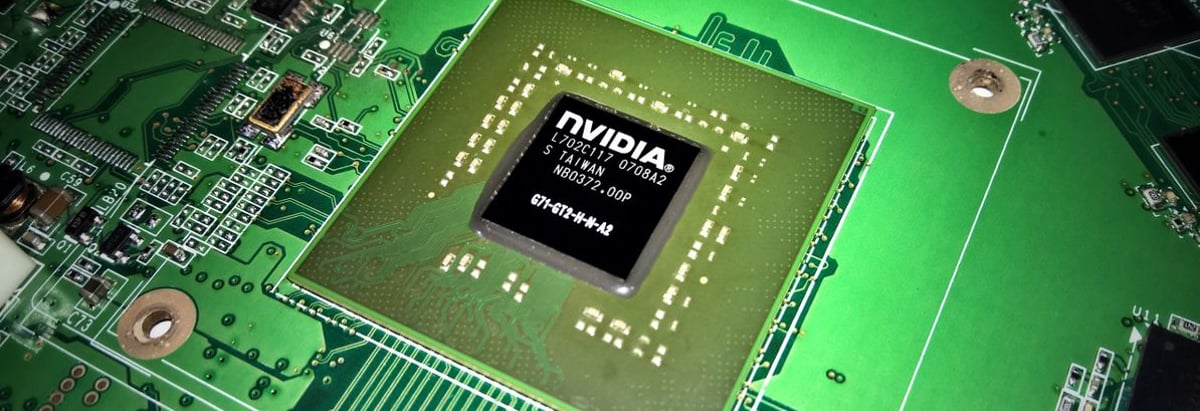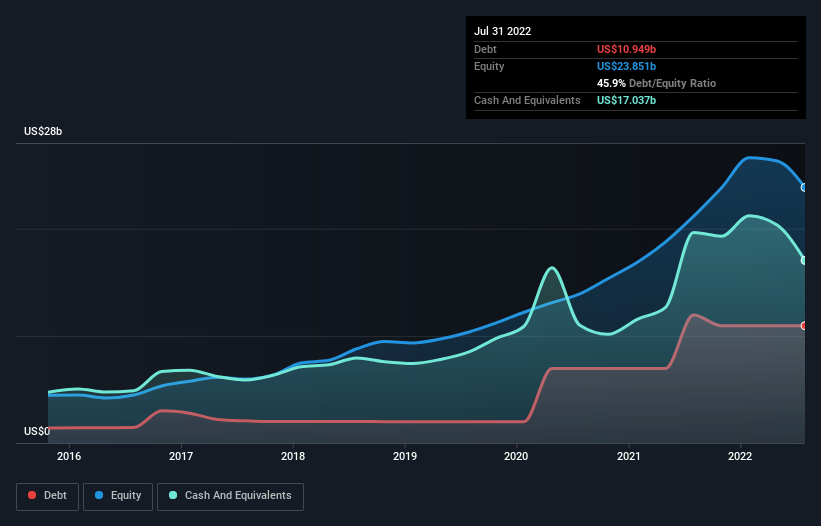Stock Analysis

Warren Buffett famously said, 'Volatility is far from synonymous with risk.' So it seems the smart money knows that debt - which is usually involved in bankruptcies - is a very important factor, when you assess how risky a company is. Importantly, NVIDIA Corporation (NASDAQ:NVDA) does carry debt. But is this debt a concern to shareholders?
When Is Debt A Problem?
Generally speaking, debt only becomes a real problem when a company can't easily pay it off, either by raising capital or with its own cash flow. Part and parcel of capitalism is the process of 'creative destruction' where failed businesses are mercilessly liquidated by their bankers. While that is not too common, we often do see indebted companies permanently diluting shareholders because lenders force them to raise capital at a distressed price. By replacing dilution, though, debt can be an extremely good tool for businesses that need capital to invest in growth at high rates of return. When we examine debt levels, we first consider both cash and debt levels, together.
Check out the opportunities and risks within the US Semiconductor industry.
How Much Debt Does NVIDIA Carry?
The image below, which you can click on for greater detail, shows that NVIDIA had debt of US$10.9b at the end of July 2022, a reduction from US$11.9b over a year. But on the other hand it also has US$17.0b in cash, leading to a US$6.09b net cash position.

A Look At NVIDIA's Liabilities
We can see from the most recent balance sheet that NVIDIA had liabilities of US$7.57b falling due within a year, and liabilities of US$12.1b due beyond that. Offsetting these obligations, it had cash of US$17.0b as well as receivables valued at US$5.32b due within 12 months. So it actually has US$2.73b more liquid assets than total liabilities.
Having regard to NVIDIA's size, it seems that its liquid assets are well balanced with its total liabilities. So it's very unlikely that the US$290.5b company is short on cash, but still worth keeping an eye on the balance sheet. Simply put, the fact that NVIDIA has more cash than debt is arguably a good indication that it can manage its debt safely.
Also positive, NVIDIA grew its EBIT by 28% in the last year, and that should make it easier to pay down debt, going forward. When analysing debt levels, the balance sheet is the obvious place to start. But ultimately the future profitability of the business will decide if NVIDIA can strengthen its balance sheet over time. So if you're focused on the future you can check out this free report showing analyst profit forecasts.
But our final consideration is also important, because a company cannot pay debt with paper profits; it needs cold hard cash. While NVIDIA has net cash on its balance sheet, it's still worth taking a look at its ability to convert earnings before interest and tax (EBIT) to free cash flow, to help us understand how quickly it is building (or eroding) that cash balance. During the last three years, NVIDIA generated free cash flow amounting to a very robust 87% of its EBIT, more than we'd expect. That positions it well to pay down debt if desirable to do so.
Summing Up
While it is always sensible to investigate a company's debt, in this case NVIDIA has US$6.09b in net cash and a decent-looking balance sheet. And it impressed us with free cash flow of US$6.3b, being 87% of its EBIT. So we don't think NVIDIA's use of debt is risky. We'd be very excited to see if NVIDIA insiders have been snapping up shares. If you are too, then click on this link right now to take a (free) peek at our list of reported insider transactions.
When all is said and done, sometimes its easier to focus on companies that don't even need debt. Readers can access a list of growth stocks with zero net debt 100% free, right now.
What are the risks and opportunities for NVIDIA?
NVIDIA Corporation provides graphics, and compute and networking solutions in the United States, Taiwan, China, and internationally.
Rewards
Earnings are forecast to grow 30.99% per year
Earnings grew by 33.1% over the past year
Risks
Significant insider selling over the past 3 months
Further research on
NVIDIA
Have feedback on this article? Concerned about the content? Get in touch with us directly. Alternatively, email editorial-team (at) simplywallst.com.
This article by Simply Wall St is general in nature. We provide commentary based on historical data and analyst forecasts only using an unbiased methodology and our articles are not intended to be financial advice. It does not constitute a recommendation to buy or sell any stock, and does not take account of your objectives, or your financial situation. We aim to bring you long-term focused analysis driven by fundamental data. Note that our analysis may not factor in the latest price-sensitive company announcements or qualitative material. Simply Wall St has no position in any stocks mentioned.